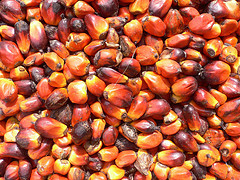What is Palm oil Used for?
Palm oil is a common cooking ingredient in the tropical belt of Africa, Southeast Asia and parts of Brazil, where it is used in the same way that other vegetable oils are commonly used in the West. As it is solid at room temperature in cooler climates, palm oil makes a cheap, vegetarian substitute for butter or other solid fats used in baking. It is used extensively in the production of a range of processed foods. In fact, in the UK, it is estimated that 33% of all the products in a local supermarket contain palm oil - that’s a lot of products! It is used in bread, cereals, chocolates, pizzas, cleaning products, chewing gum and even shampoo.
Palm oil’s high saturate content makes it ideal for creating a crispy coating on fried products, but also make it a useful addition to lipsticks, where it adds a glossy look, or to cleaning products, where it creates foam. The famous soap brand ‘Palmolive’ was named after the palm and olive oils that gave it a smooth texture.
As well as being used in products for human consumption, palm oil is widely used in animal feed. The UK uses a considerable 10% of the global supply in palm kernel meal, and 80% of this is used to feed pets and livestock. Palm oil has also been used to make milk substitutes to feed to calves in dairies!
 Palm oil isn’t only used for food and beauty products, it can also be used as a fuel, known as a ‘biodiesel’ (a non fossil fuel, created from living materials, such as plants). More than 50% of the palm oil imported into Europe in 2018 was used for vehicle fuel. The shells of the palm that have had their pulp extracted to make oil, can be used to make biofuels themselves. Palm oil can also be reused. After it has been used to fry foods, used cooking oil can be chemically treated to create a biodiesel for use in vehicles or for heating. Ironically, palm oil was first sought out as a biofuel, in an attempt to find a more environmentally friendly alternative to existing fossil fuels. However, studies suggest that palm oil biodiesel produces three times as much carbon a a fossil fuel equivalent.
Palm oil isn’t only used for food and beauty products, it can also be used as a fuel, known as a ‘biodiesel’ (a non fossil fuel, created from living materials, such as plants). More than 50% of the palm oil imported into Europe in 2018 was used for vehicle fuel. The shells of the palm that have had their pulp extracted to make oil, can be used to make biofuels themselves. Palm oil can also be reused. After it has been used to fry foods, used cooking oil can be chemically treated to create a biodiesel for use in vehicles or for heating. Ironically, palm oil was first sought out as a biofuel, in an attempt to find a more environmentally friendly alternative to existing fossil fuels. However, studies suggest that palm oil biodiesel produces three times as much carbon a a fossil fuel equivalent.
